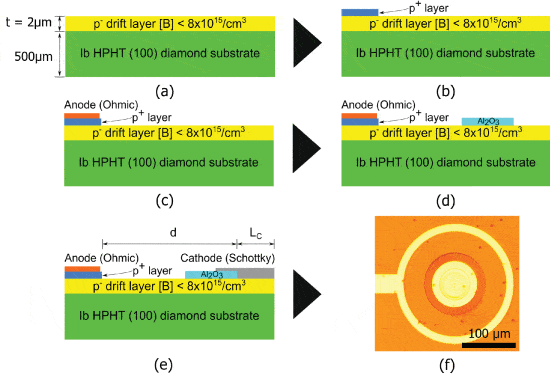At 200 degrees Celsius and under a 40-volt forward bias, they showed a peak current density of 5.39 milliamperes per millimeter.
In pursuit of carbon neutrality by 2050, the University of Illinois Urbana-Champaign researchers have made a groundbreaking advancement with a diamond semiconductor device. This device boasts the highest breakdown voltage and the lowest leakage current among diamond devices, marking a significant step towards efficient technologies for renewable energy transition.
Diamond-based p-type lateral Schottky barrier diodes (SBDs) with a 2-micrometer thick drift layer have been developed, both with and without Al2O3 field plates. The Schottky contacts, consisting of layers of Mo, Pt, and Au, demonstrated a barrier height of 1.02 ± 0.01 electronvolts. The ohmic contacts, made of Ti, Pt, and Au, achieved a specific ohmic contact resistance of approximately 1.25 × 10^−4 ohm-centimeters squared.
Detailed examination of their forward and reverse bias characteristics revealed that both types of SBDs maintain a rectifying ratio greater than 107 at room temperature. At 200 degrees Celsius and under a 40-volt forward bias, they showed a peak current density of 5.39 milliamperes per millimeter.

Their leakage current density at room temperature remained stable at around 0.01 milliamperes per millimeter for both diode types. The SBD without the Al2O3 field plate reached a breakdown voltage of 1159 volts, whereas the one with the Al2O3 field plate demonstrated a significantly higher stability under a reverse voltage of 4612 volts, surpassing many previously reported diamond SBDs.
Currently, power devices control 50% of the world’s electricity, expected to rise to 80% by 2050, alongside a 50% increase in electricity demand. The National Academies of Sciences, Engineering, and Medicine highlight the urgency of modernizing the electrical grid to support renewable energy deployment and reduce fossil fuel emissions.
While diamond is often associated with luxury, lab-synthesized diamond offers an affordable, sustainable semiconductor alternative. This artificial diamond, produced with abundant carbon, generates far less carbon emissions compared to natural diamond formation.






